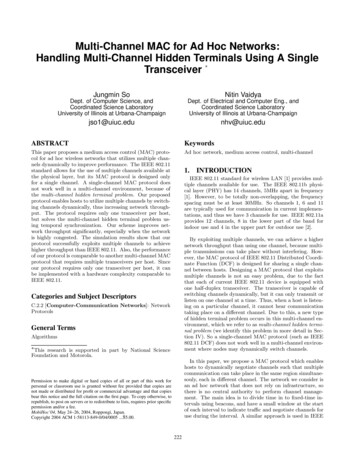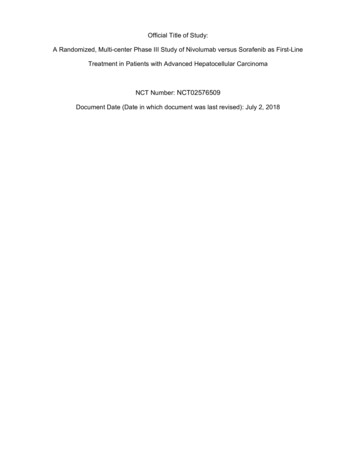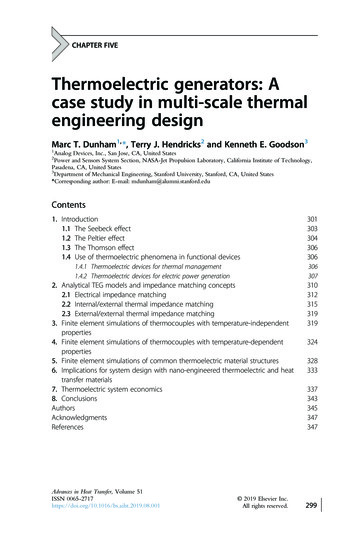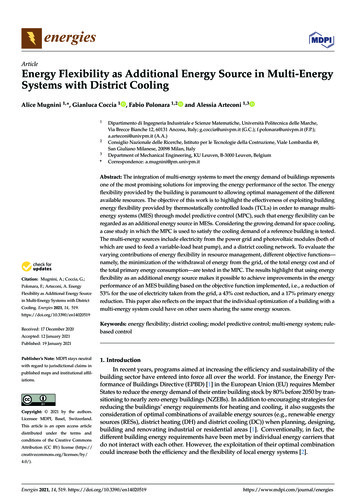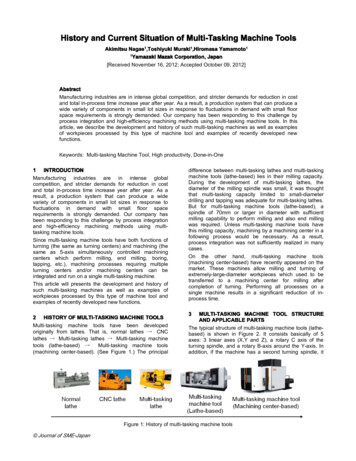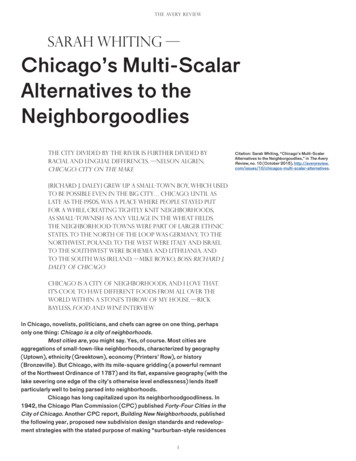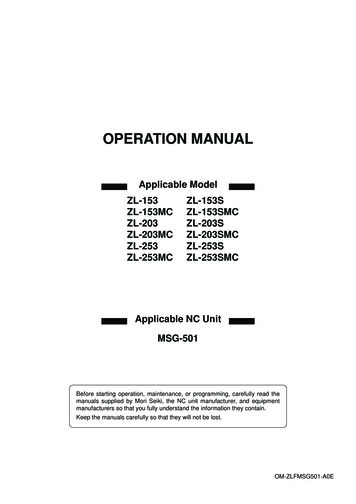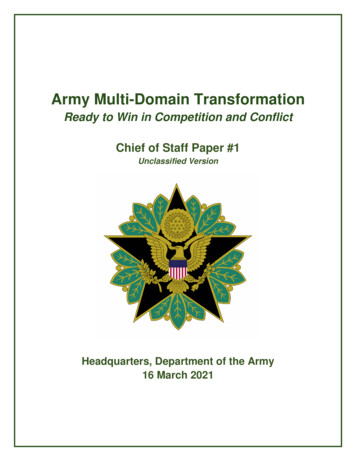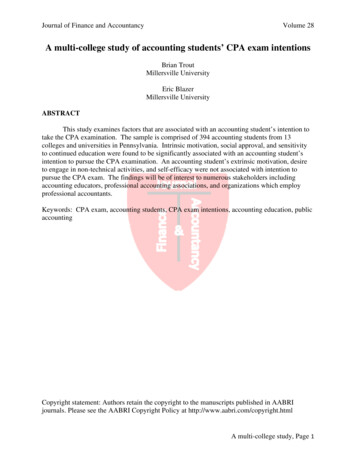
Transcription
Journal of Finance and AccountancyVolume 28A multi-college study of accounting students’ CPA exam intentionsBrian TroutMillersville UniversityEric BlazerMillersville UniversityABSTRACTThis study examines factors that are associated with an accounting student’s intention totake the CPA examination. The sample is comprised of 394 accounting students from 13colleges and universities in Pennsylvania. Intrinsic motivation, social approval, and sensitivityto continued education were found to be significantly associated with an accounting student’sintention to pursue the CPA examination. An accounting student’s extrinsic motivation, desireto engage in non-technical activities, and self-efficacy were not associated with intention topursue the CPA exam. The findings will be of interest to numerous stakeholders includingaccounting educators, professional accounting associations, and organizations which employprofessional accountants.Keywords: CPA exam, accounting students, CPA exam intentions, accounting education, publicaccountingCopyright statement: Authors retain the copyright to the manuscripts published in AABRIjournals. Please see the AABRI Copyright Policy at http://www.aabri.com/copyright.htmlA multi-college study, Page 1
Journal of Finance and AccountancyVolume 28INTRODUCTIONReports such as the American Institute of Certified Public Accountants’ (AICPA)“Trends in the Supply of Accounting Graduates and the Demand for Public AccountingRecruits” (AICPA, 2019) have raised concerns about the declining number of CPA examinationcandidates. This trend may have important implications on the public and profession consideringthe high number of CPAs that are expected to retire in the next decade (AICPA, 2016; Boomer,2018).This study examines numerous factors which may affect accounting students’ intentionsrelated to pursuing the CPA examination. The sample is drawn from accounting studentsenrolled in colleges and universities throughout Pennsylvania and goes beyond studentdemographics to examine how students’ perceptions, attitudes, and motivations may impact theirplans to take the CPA examination. There are numerous articles examining students’ perceptionsrelated to accounting as a subject and profession but studies which examine students’ intentionsin relation to taking professional certification examinations are limited. The literature review isstructured to summarize existing articles by the independent variables included in the study. Thereview is followed by a summary of the methodology, the results of the questionnaire, and adiscussion related to the most interesting findings.LITERATURE REVIEWEducation requirementsWhile the CPA examination is the same in all jurisdictions, the eligibility requirementsfor taking the examination are not. Some states allow candidates to sit for the examination aftercompleting their standard 120 credit hour bachelor’s program. Others require 150 semesterhours. To obtain 150 hours of education, students may obtain a master’s degree but it is notrequired (AICPA, n.d.-b). Semester hours required in specific accounting courses vary byjurisdiction. Currently, the U.S. Virgin Islands is the only U.S. jurisdiction that does not requireat least 150 hours of education for licensure (NASBA, n.d.).The objective of implementing the 150-hour requirement was to improve the overallquality of work performed by CPAs (AICPA, n.d.-a). Research related to the effect of the 150credit hour requirement on students’ CPA intentions is mixed. Many authors posit that the 150credit hour requirement is associated with a decrease in CPA candidates (A. Allen & Woodland,2006; Bierstaker et al., 2004; Carpenter & Hock, 2008; Carpenter & Stephenson, 2006; Jackson,2006). Carpenter and Stephenson (2006) found that while the number of candidates increasedsignificantly in the year before the 150-hour rules went into effect, the subsequent impact was a60 percent reduction in CPA examination candidates, using data from 1985-2002. Allen &Woodland (2006) found a 33 percent average decline in candidates when analyzing data from theNational Association of State Boards of Accountancy (NASBA) related to the period of 19912002. Underlying factors that contribute to the 150-hour’s effect on intention to take the CPAexamination have not been addressed in literature. Examples include factors such as theopportunity cost associated with meeting the requirements, increased out-of-pocket costs, oracademic rigor.Metinko and Gray (2010) found no relationship between the number of CPA examcandidates and the education requirements in each of the US jurisdictions. Schroeder and FranzA multi-college study, Page 2
Journal of Finance and AccountancyVolume 28(2004) studied the immediate and short term effects of 150-hour requirement’s implementation.The researchers found that first time candidates dropped in the year the new requirement tookplace, but first time candidates recovered uniformly to approximately 50-60 percent of thebaseline period in subsequent years. The authors’ conclusion was that the 150-hour rule was notprimarily responsible for the decline in first time CPA examination candidates. In terms ofstudents’ perceptions, Schroeder and Franz cited a July 2000 study by the Taylor Research andConsulting Group which found that students do not consider the 150-hour rule to be a barrier. 76percent of high school students and 80 percent of college students who participated in the surveyalready had plans to pursue a graduate degree. Nelson, Vendrzyk, Quirin, and Kovar's (2008)15-year longitudinal study of accounting students supports the claim that more students intend topursue graduate degrees. However, Charron and Lowe's (2009) survey of accounting alumnifound that 40 percent of graduates who had achieved the required credits had not taken a singlepart of the CPA examination. Half of the “exam ready” graduates had achieved the requiredcredits more than one year earlier.Research question one asks “To what extent do educational requirements influence astudent’s intention to take the CPA examination?”Theory of planned behaviorThe next three factors affecting students’ intentions to pursue the CPA examination aregrounded in beliefs. Many articles have examined how students’ beliefs impact their pursuit ofvarious career paths (C. L. Allen, 2004; Cohen & Hanno, 1993; Dalton et al., 2014).Researchers examining accounting students’ beliefs in relation to their intentions to pursue theCPA examination point to the theory of planned behavior (Coe, 2016; Sandra Felton et al., 1995;Wen et al., 2015). The theory of planned behavior contends that intention is the best predictor ofbehavior (Ajzen, 1991).Social influence. Social influence, or “subjective norm”, is one of the three variablesunderlying the theory of planned behavior. Subjective norm is an individual’s perception ofwhether people who are important in the individual’s life (referents) favor a behavior (SandraFelton et al., 1995). It can also be thought of as the perceived social pressure or approval ofcertain behaviors. For example, a student who believes a teacher or family member would wanthim or her to take the CPA exam may be more inclined to pursue this endeavor. Wen, Hao, andBu (2015) found that the influence of referents positively influence Chinese accounting students’intentions to pursue the CPA examination. Coe's (2016) study of upper level division accountingstudents found factors such as the perception of social support from friends and family, access toa role model who is a CPA, and support from college faculty to take the CPA examination to bepositively associated with the intention to sit for the CPA examination. One party that does notappear to be exerting a high level of influence is employers. While public accountants reportsignificantly higher perceived pressure to pass the CPA from their employers than accountants innon-public jobs, the mean rating reported by a sample of accounting alumni was 4.6 on a 7-pointLikert scale (Charron & Lowe, 2009). In 2004, a joint task force of the AICPA, NASBA, andThomson Prometric Inc. was assembled to research why enrollment declined substantially in thefirst year of computerized testing. Interestingly, respondents did not report the computerized testas an obstacle. Instead, they reported feeling no pressure from their employers to take the CPAexaminations and also cited work and family commitments as hindrances (Journal ofAccountancy: Professional Issues, 2005).A multi-college study, Page 3
Journal of Finance and AccountancyVolume 28Research question two asks “To what extent does social influence affect a student’sintention to take the CPA examination?”Self-efficacy. The CPA examination can be a daunting pursuit. The average candidaterequires roughly 17-18 months and six total attempts to pass the fourth part of the examination(2014 Candidate Performance Book: The University Edition, 2014). Self-efficacy is theconfidence in one’s own ability to achieve intended results (Ormrod, 2006). Studies have foundself-efficacy to be positively related to a student’s decision to join the accounting profession(Hayes & Credle, 2008; James & Hill, 2009). Coe (2016) found that self-efficacy was positivelyassociated with the intention to sit for the CPA examination as soon as a candidate is eligible.Wen et al. (2015) found that the perceived incapability to succeed was negatively associated withthe intention to pursue the CPA examination. Timing may also affect self-efficacy. CPA examdata consistently show a higher pass rate for candidates who test soon after meeting theeducational requirements (NASBA, 2017). As potential candidates delay taking the exam andbecome further removed from school, they may perceive passing the exam to be more difficult(Arens & Elder, 2006; Buchanan et al., 2004; Weidman, 2006). In general, literatureconsistently shows that students who believe they will succeed are more likely to engage in achallenging undertaking like the CPA examination.Research question three asks “To what extent does self-efficacy influence a student’sintention to take the CPA examination?”Intrinsic and extrinsic motivation. Beliefs about the consequence of a behavior and thedesirability of the consequence is the third factor in theory of planned behavior. These beliefscenter on intrinsic and extrinsic motivators. For example, the belief that taking the CPAexamination will contribute to securing a fulfilling (intrinsic) or well paying (extrinsic) job willlikely increase the intention to sit for the examination. Students’ positive attitudes towardaccounting as a profession are commonly grounded in extrinsic factors such as salary prospects,job security, and opportunities for advancement (Ahmed, 1997; S. et al. Felton, 1994; Franciscoet al., 2003; Germanou & Hassall, 2009; Mustapha & Abu Hassan, 2012; Nelson et al., 2008;Stivers & Onifade, 2014; Sugahara et al., 2008). Many students feel that a career in accountingwill have little personal satisfaction (C. L. Allen, 2004; Marriott & Marriott, 2003; Stivers &Onifade, 2014).While Wen et al. (2015) found students associate extrinsic factors with the CPAcredential, these researchers found intrinsic factors to be significant in relation to students’intentions to pursue the CPA examination. Coe (2016) also found students’ genuine interest inaccounting to be positively associated with intention to pursue the CPA exam but did not find asignificant positive relationship between perceived better financial compensation and the choiceto pursue the CPA credential. Intrinsic motivation comes from within an individual. It is notdriven by external rewards. Instead, interest in an activity is stimulated from the personalsatisfaction or fulfillment derived from the activity. Jackling and Calero (2006) found thatpersonal satisfaction with studies in accounting was the most significant predictor of intention tobecome an accountant.Research question four asks “To what extent does intrinsic motivation influence astudent’s intention to take the CPA examination?”Research question five asks “To what extent does extrinsic motivation influence astudent’s intention to take the CPA examination?”A multi-college study, Page 4
Journal of Finance and AccountancyVolume 28Desire to engage in non-technical business activitiesStereotypes can impact the selection process of individuals choosing a profession(Arguero & Howard, 2009). Holland (1973) found that individuals base career selections onvocational stereotypes because vocation interest can be a way for individuals to express theirpersonalities. Negative stereotypes may lead students to view a career track as incompatiblewith their self-image. Many studies find that students perceive the subject of accounting to bedull or boring (Larkin, 1991; Lehman, 2001; Picard et al., 2014; Stivers & Onifade, 2014).The reality is that an accountant’s role has transitioned from “bean counter” to “businesspartner” (Institute of Management Accountants, n.d.). Rapid advancements in technology andglobalization have contributed to this change (Albrecht & Sack, 2001; Mohamed & Lashine,2003). Traditionally, public accountants were primarily preparing financial information fordecision makers, auditing financial statements, or assisting with tax and other regulatoryrequirements. Today’s competitive environment has compressed margins on many servicespreviously offered by public accounting firms. Consequently, firms are channeling theirresources into advisory and consulting services and outsourcing lower-value services. Theemphasis is no longer value stewardship (e.g. auditing, statutory reporting, compliance); it isvalue creation (e.g. financial planning and analysis) (Siegal et al., 2010; Thomson, 2017).Accordingly, accounting firms are rebranding themselves as “professional service firms”(Albrecht & Sack, 2001).The shift away from preparers to advisors means today’s accountants, more than ever,need to possess criti
him or her to take the CPA exam may be more inclined to pursue this endeavor. Wen, Hao, and Bu (2015) found that the influence of referents positively influence Chinese accounting students’ intentions to pursue the CPA examination. Coe's (2016) study of upper level division accounting students found factors such as the perception of social support from friends and family, access to a role .
